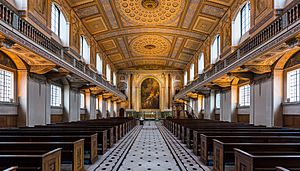John Papworth (plasterer) facts for kids
John Papworth (1750–1799) was a very skilled plasterer and stucco artist who worked in London during the late 1700s. Stucco is a special kind of plaster used to decorate walls and ceilings, often made to look like stone.
John Papworth: A Master Decorator
Early Life and Famous Projects
John Papworth came from an Italian family. He learned his skills from a famous stucco artist named John Rose. Later, Papworth started his own business. He often worked for a well-known architect named Sir William Chambers, who considered him his favorite stucco artist.

Starting in 1780, Papworth was the main plasterer at important places like St James's Palace and Kensington Palace. He also did the plasterwork in the Royal Academy Room at Somerset House. He created the beautifully decorated ceilings in the chapel at Greenwich Hospital, London. This was when the chapel was rebuilt in the 1780s by architect James "Athenian" Stuart, after a fire had destroyed it.
In 1781, Papworth traveled to Scotland. There, he worked for architect Robert Milne at Inveraray Castle. He sent a bill for his detailed plasterwork on the ceilings and walls of the hall and dining room. At Somerset House in 1784, he worked with another plasterer, Thomas Collins. Together, they earned a lot of money for their projects. Between August and November 1789, he worked at the home of George Herbert, 2nd Earl of Powis in Berkeley Square. Here, he fixed and decorated parts of the walls and ceilings. By the late 1790s, Papworth had a workshop at 86 Great Portland Street in London. He shared this space with his son, John Buonarotti Papworth, who was just starting his career in architecture.
Family and Legacy
John Papworth was married to Charlotte Searle, and they had twelve children! He described himself as an "architect, plasterer, and builder." He was very important in the decorative plasterwork business in London during the late 1700s. He even employed more than 500 men!
After his death, his oldest son, Thomas, continued the family business. His second son, John Buonarotti Papworth, also followed in his footsteps. He became known as "one of the most flexible architects and decorative artists of his time." Papworth's third son, George, was also an architect, mainly working in Ireland. Many of Papworth's family members became famous architects, like John Woody Papworth, and writers about art.

